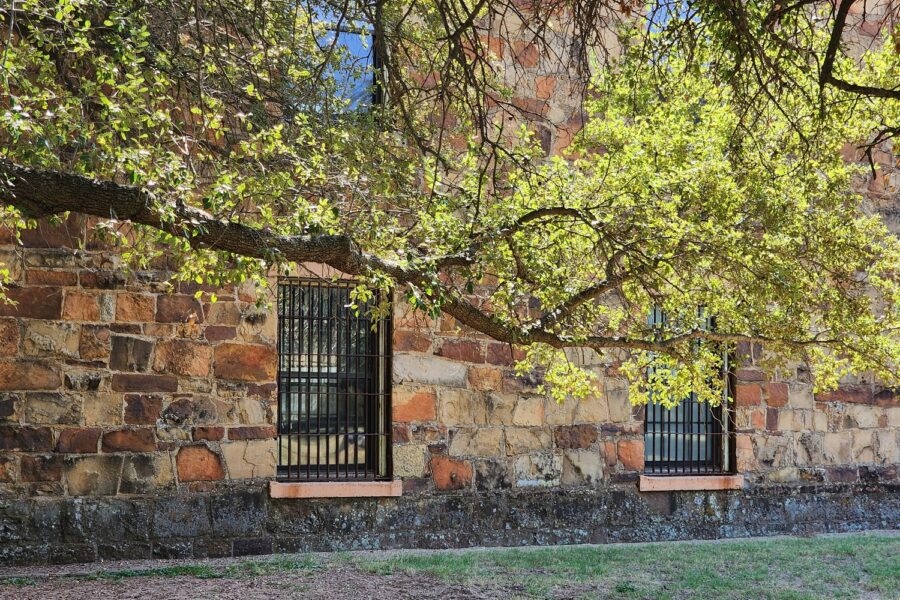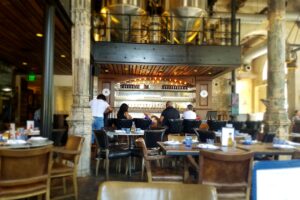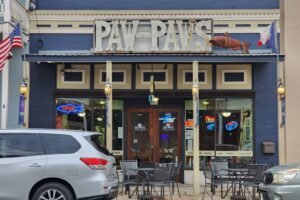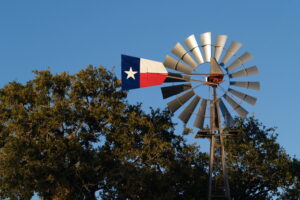This happens to us all the time! It’s a Thursday and the fort should not be closed! But checking the particulars on just how to find the entrance to Fort Belknap Google does not give me good news. I definitely feel a need for a frowny face emoji. I look at Michael and tell him, “Google says Fort Belknap is closed!”
Flexible soul that he is, Michael replies, “Oh well, we can always look over the fence.”
However, when we arrive at the entrance to the fort, the gate is open, but the parking lot is empty. There is no one to tell us NO, STAY OUT, and no sign instructing us not to continue our quest, so we park our bright red ride. If we’re intruding, the caretakers won’t have trouble knowing we are here.
Not able to wait to explore, Michael immediately exits the car and begins to walk. It takes me a while longer as I root around through all the books and brochures at my feet, trying to find the book on Texas Forts I am sure is here somewhere. Turning to the page indicated on the index, I discover this book has a lot to say about Fort Belknap; this will take longer than a minute.
Waving furiously at Michael, I suggest that before looking at the exterior of the buildings, we sit at a picnic table under the extensive grape arbor, learn about where we are, and then nose around the empty fort. Surprisingly, he agrees. We sit. I read.


A Book – Frontier Forts of Texas
Built as part of the US’s pledge to defend the Texas frontier, Fort Belknap was established in the early summer of 1851 as the northern anchor of a line of posts stretching from the Red River to the Rio Grande. Federal Troops abandoned the fort eight short years later, in 1858, shortly before, and because of, the impending Civil War. There was also no longer a need for defense against warring Comanches and other tribes; they were relocated to an Oklahoma Indian Reservation.
I’m torn in two whenever I think about these things—people fighting for their land, defending their way of life, and then being punished—outcasts. It is the story of my grandmother’s parents and so many others. People fleeing oppression become the oppressors in a new land. It seems to be the way of the world since the beginning of time. But I try to shake these thoughts from my head.
Returning to the present, I consider my surroundings and the history of the fort surrounding me—the book in front of me. We discover that the first choice of a site is not always the best choice, and some generals stick by their guns—no matter what. It took two dry holes sixty feet deep—dug by soldiers in the candlelight because it was too hot in the Texas sun to dig by day—with nary a drop of water to be found to convince a captain that the fort’s location needed to be moved. Out loud, I read a full page devoted to whisky rations, drunkenness, and the evil consequences of drinking spiritous liquors. My throat becomes dry and my voice cracks. “This is too long for me to read,” I croak, “fourteen pages! I have barely read two. Maybe we need to read it on our own—tonight.”
Exploring the Grounds



Today the grounds of the fort look like a city park; well, it is a county park, Michael reminds me. Large shade trees are everywhere, and although not bright green, the grass is not dried straw either. Michael walks one way—I walk the other and become fascinated with the Corn House—a place to store feed for the horses.
Childhood memories intrude on my musings of soldiers and wells and warring Indian tribes. I think instead of the corn crib at my grandmother’s farm and helping my aunts shell corn each day to feed the chickens. It was one of my favorite things to do during my summertime forays into country life. The corn crib was a ramshackle wooden barn on posts about two feet off the ground—the Corn House before me is solid and squat and made of stone.


Powder Magazine, Kitchen and Barracks
Wandering further, I discover that not all of these buildings are original to the fort; only the Powder Magazine stands as it once was. The other six buildings are replicas, built in 1936 by the WPA to celebrate the Texas Centennial. Three of the structures are barracks, one a kitchen, another the corn house, and finally, the large centerpiece of the now 20-acre county park—a commissary/museum.
The Museum and Freddie
Learning there is a museum, I look for the entrance. The door is closed, so I try opening it—locked. I peek in the windows. I turn in surprise when I hear a voice behind me say, “I’ll open it in a few minutes, but first, I need to help my son load a cannon on his truck.”


Museum Entrance & Well
Michael joins me, and we wait for the museum to open in the shade of the old well. When finally we gain entrance, the first thing Michael wants to know about is the cannon. We discover it is on its way to Fort Griffin as part of their historical reenactment this coming Saturday. What I want to know about is Freddie, who he is, and why he is here.
I discover that Freddie is the father of the Director of Fort Belknap and helps out when needed. Today he needed to help his son clean and load the cannon so it can look its shiny best on Saturday. He also helps at the museum and fills in for his son when he needs to travel. I’m not sure about his son, but Freddie is a font of information, and I love to hear him talk. We then spend the next several hours listening to him tell us tales about the distant and recent past, his current life, and the future plans and happenings at Fort Belknap. I try hard to remember it all.





Most of the items displayed in the museum were donations from county residents, not all displays pertain to army life. But, it is all interesting.
Fort Belknap
Fort Belknap, located near Newcastle, Texas, was established in November 1851 by brevet Brigadier General William G. Belknap to protect the Texas frontier against raids by the Kiowa and Comanche. It was the northernmost fort in a line from the Rio Grande to the Red River
Address: 114 Fort Cir, Newcastle, TX 763
Hours:
- Monday – Saturday – 9 am to 5 pm
- Sunday- 1:30 pm to 5 pm
- Closed Wednesday
- Closed for lunch 12 pm-1:30 pm
Phone: (940) 846-3222
To see more stories on other Forts, click on the following link:
https://www.charlottestexashillcountry.com/category/texas-beyond-the-hills/texas-forts/
If you are interested in Texas History and want to read in-depth information, the following book is available on Amazon:
Frontier Forts of Texas Hardcover – January 1, 1966, by Roger N. Conger (Adapter), Kenneth F Neighbours (Author), James M. Day (Author)









Leave a Reply
Your email is safe with us.